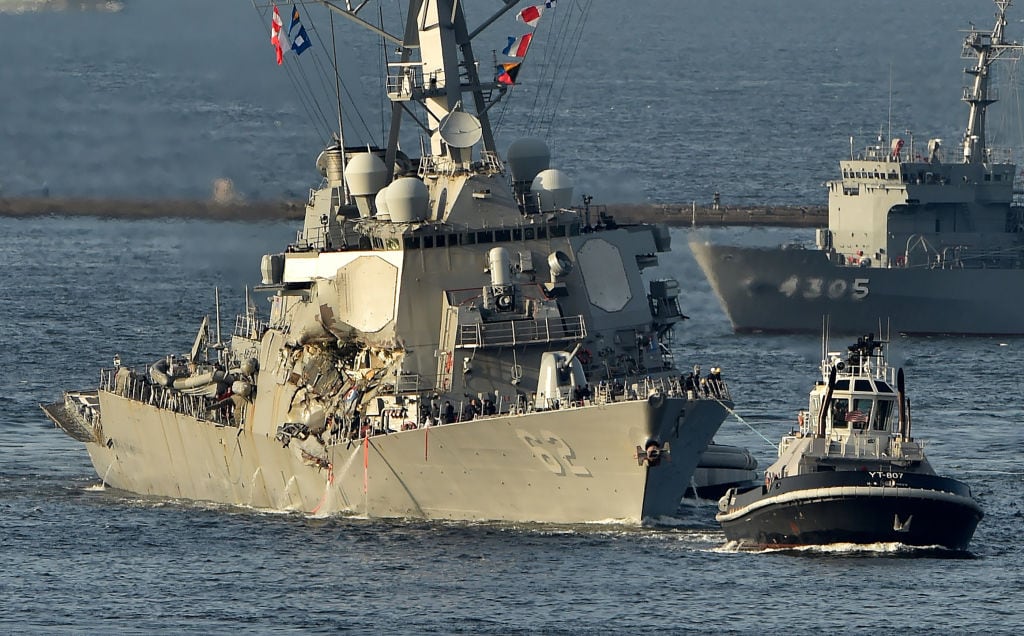WASHINGTON – In one of the most remarkable U.S. Navy documents in recent memory, the service is admitting to widespread failures and training shortfalls at the core of its most basic function: safely operating ships at sea.
A comprehensive review of the Surface Navy conducted by the Navy’s Fleet Forces Command found that both the Japan-based 7th Fleet headquarters leadership and its ship commanders allowed training and proficiency to erode as they sought to keep ships underway to meet operational requirements.
“The risks that were taken in the Western Pacific accumulated over time and did so insidiously,” according to the report released Thursday. “The dynamic environment normalized to the point where individuals and groups of individuals could no longer recognize that the processes in place to identify, communicate and assess readiness were no longer working at the ship and headquarters level.”
The problems became easy to ignore because, prior to the mishaps, they were still getting the job done, the report argues.
RELATED

The comprehensive review, led by fleet boss Adm. Phil Davidson, found that the issues in 7th Fleet were in some ways unique to the pressures and demands in the Pacific region, the Navy’s most fast-paced and dangerous operating environment, but in other ways pointed to serious lapses in training and evaluation of its officers and sailors.
The review raised troubling questions about the ability of surface warfare officers in today’s fleet and their ability to act under pressure.
In a detailed analysis of the four major accidents in 7th Fleet this year — two deadly collisions, a grounding and a minor collision with a fishing boat — the review found that officers and enlisted sailors performed poorly when faced with a dangerous situation.
The review ascertained that in all four incidents this year, when the crews were faced with an extreme situation, they delayed actions, froze and did not alert their crews of imminent danger.
“Incorrect actions in extremis were a contributing factor to the chain of errors that resulted in the incident[s],” the report reads.
The report also found that teamwork was at times non-existent between the bridge and the ship combat information centers, the place that displays and synthesizes the information from a ship’s sensors and weapons systems.
Furthermore, the review determined that sailors had routinely failed to use the tools available to them to increase awareness of their situations.
In the review, the Navy also acknowledges that its surface warfare officers lacked sufficient navigation and seamanship skills, and recommends creating an “objective, standardized assessment program to periodically assess individual seamanship and navigation skills over the course of a surface warfare officer’s career.”
The review details steps, including new evaluation processes, to correct the issues.
In regards to the issues at 7th Fleet, the review argues that leaders in the region were blinded by operational commitments and that cutting corners became the norm in order to fulfill commitments.
“Evidence of skill proficiency on ships and readiness problems at headquarters were missed, and over time, even normalized to the point that more time could be spent on operational missions,” the document reads. “Headquarters were trying to manage the imbalance, and up to the point of the mishaps, the ships had been performing operationally with good outcomes, which ultimately reinforced the rightness of trusting past decisions.
“This rationalized the continued deviation from the sound training and maintenance practices that set the conditions for safe operations.”
The collisions of the destroyers John S. McCain and Fitzgerald this summer led to the relief of both commanding officers and several other crew members, as well as the destroyer squadron commander, the Ronald Reagan Carrier Strike Group commander and the 7th Fleet Commander.
The Navy briefed the findings of the review to Congress earlier in the week, and was set to roll out its review to the public Thursday afternoon.
David B. Larter was the naval warfare reporter for Defense News.




